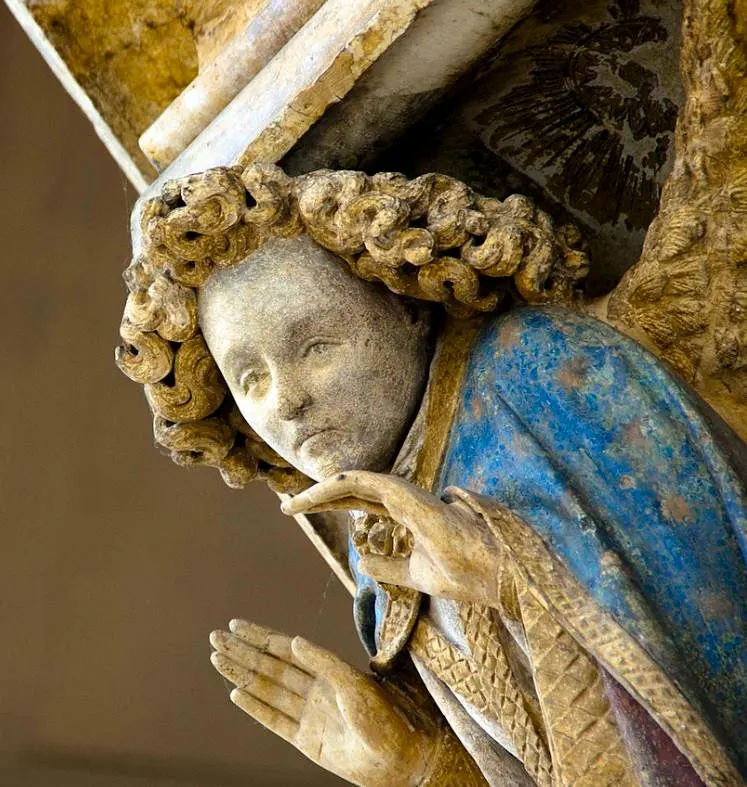One of the greatest sculptural achievements of the late Middle Ages can be found in a city that was once the Burgundian capital in modern-day France.
The Well of Moses is an incredible Gothic artwork that is unique in many ways. It’s incomplete today but it provides great insight into how the transition between the Gothic and Renaissance periods happened.
Let’s take a closer look at this incredible monument just outside of Dijon so you can get a complete picture of Claus Sluter’s masterpiece.
1. It took 8 years to complete in the late 14th and early 15th centuries
The Well of Moses is a magnificent sculptural group that was carved in a period that marks the transition between Gothic art and Renaissance art.
It was completed by Dutch artist Claus Sluter (1340-1406) between 1395 and 1403. He was working in the Duchy of Burgundy since 1380 and completed many works in and near Dijon, the Duchy’s capital city at the time.
He didn’t complete this monumental work of art by himself because he had the help of his nephew Claus de Werve and other members of his workshop.

2. It once decorated a large Carthusian Monastery just outside of Dijon
The sculptures of the Well of Moses were just a few of the countless works of art that were commissioned to decorate the Chartreuse de Champmol.
This Carthusian monastery was established in 1383 just west of the historical heart of Dijon, a city in the eastern part of France.
The idea behind this monastery was to both serve as a burial site for the Valois Dukes of Burgundy and to store the abundance of fine art owned by the Dukes.

Claus Sluter completed several other sculptures for this monastery, including those at the portal of the monastery church and other funerary sculptures.
The monastery was dissolved during the French Revolution and many artworks were damaged during this hectic period in the late 18th century.
Today, it mainly serves as a mental hospital and “Aller à la Chartreuse” (Going to Chartreuse) is a common local expression for saying that somebody has mental health problems.

3. It was commissioned by the Duke of Burgundy
The Well of Moses was commissioned by Philip II the Bold (1342-1404), the Duke of Burgundy, and the man who had established the Chartreuse de Champnol in the early 1380s.
As you can see in the image above, the well was located in the immense courtyard that was surrounded by the houses of the monks, workers, and servants of the monastery.
Philip II the Bold lived to see the sculpture completed as he died a year after it was completed in 1404.

4. The sculptural group features 6 prophets and 6 weeping angels
The sculptural group consists of 2 sets of 6 sculptures:
- The 6 prophets who had foreseen the death of Jesus Christ (Moses, David, Jeremiah, Zachariah, Daniel, and Isaiah-.
- 6 angels are placed on slender columns that encircle the hexagonal base.
The angels distinctively weep, an element that Claus Sluter integrated for figures of other funerary monuments that he completed at the monastery as well.

5. The sculptures were brightly painted and the monument misses the upper part
Unfortunately, the Well of Moses isn’t complete anymore. It originally featured a large Calvary scene that stood on top of the hexagonal base of the monument.
It was long believed that this Calvary group featured multiple other figures, including the Virgin Mary and Saint John.
Today, however, it’s fairly certain that only Mary Magdalene was depicted weeping at the feet of Jesus Christ as he was carrying his cross.
Another remarkable fact about the Well of Moses is that it looked completely different upon completion than it looked today.
All figures were brightly painted by the Dutch court painter Jean Malouel (1365-1414). Some traces of this paint are still visible today.

6. The man who commissioned the monument is depicted as one of the prophets
The first thing you’ll notice when you closely examine the prophets is that Jeremiah has a rather arrogant look on his face.
It’s fairly certain that this is a portrait of Philip II the Bold himself. Jeremiah was the most popular of all prophets of the Carthusian Order so that makes sense.
The Duke of Burgundy is featured in the portal of the monastery church as well together with his wife Margaret III of Flanders (1350-1405). The striking resemblance removes all doubt that this is indeed the Duke.

7. How big is the Well of Moses by Claus Sluter?
Because the entire top section of the monument is missing, it’s much smaller today than it was upon completion in 1403.
The amazing sculptural group still stands almost 7 meters (23 feet) tall. Including the crucifix on top, the monument reached a height of 13 meters (42.65 feet)!

8. You can find fragments of the missing upper section in a museum in Dijon
The monument is located inside a building in the central courtyard of the monastery which is now known as the “Hospital de la Chartreuse.”
This structure was only constructed in the 17th century. before that, it stood in the open air.
The upper section already suffered damage because it had to face harsh weather conditions. The Calvary scene was further damaged during the French Revolution in the early 1790s and only fragments remain today.
The most remarkable surviving fragment of the upper section is the head and torso of Jesus Christ which is on public display at the Musée Archéologique in Dijon.

